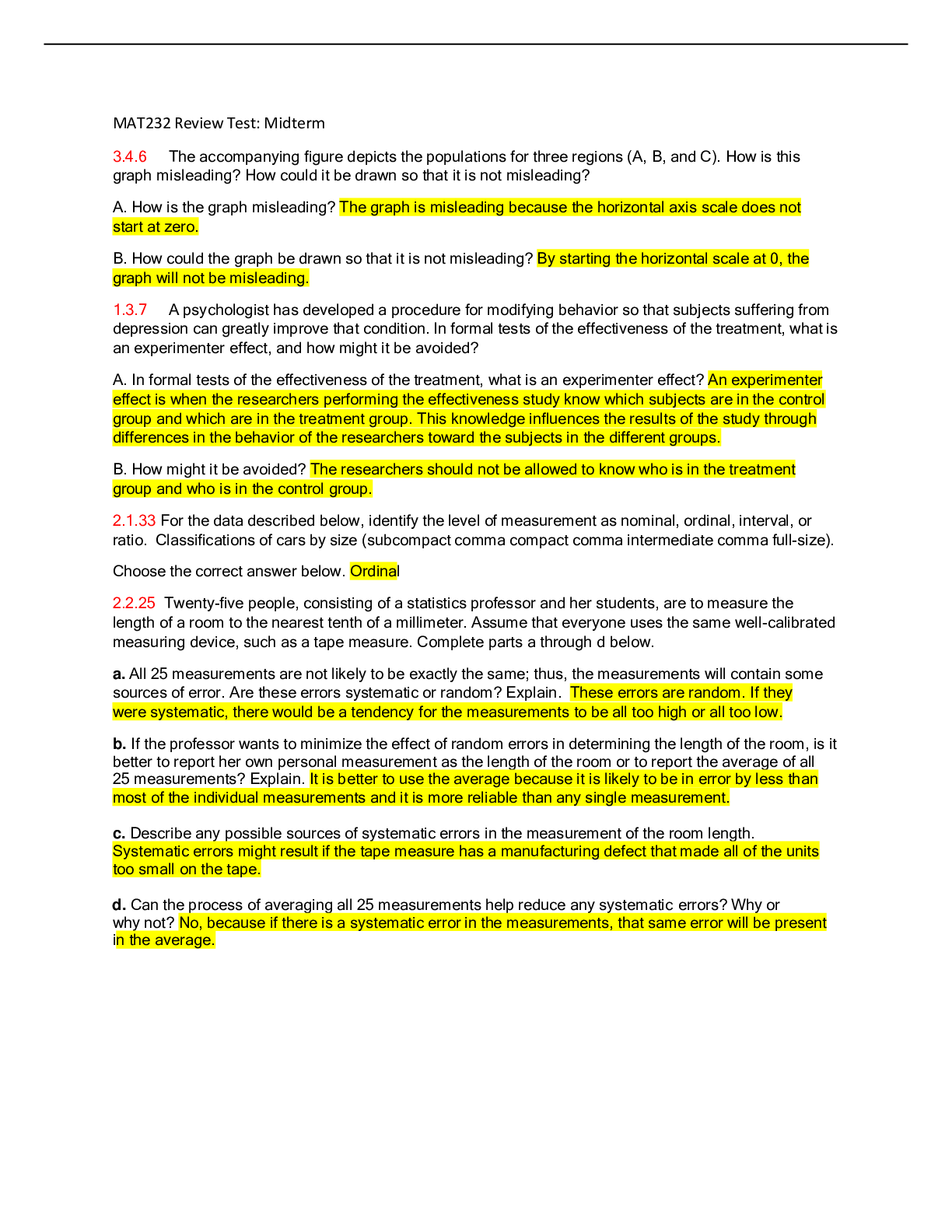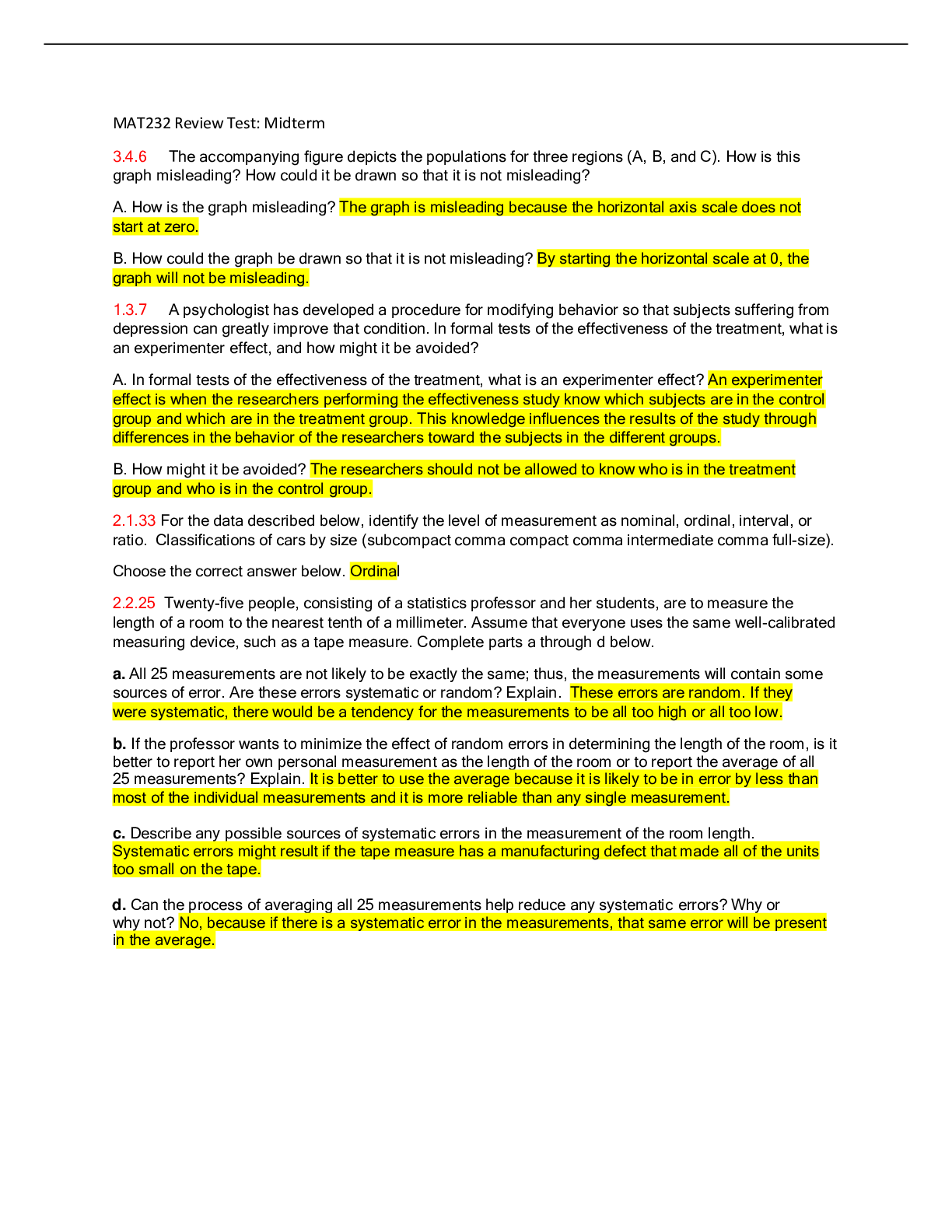3.4.6 The accompanying figure depicts the populations for three regions (A, B, and C). How is this
graph misleading? How could it be drawn so that it is not misleading?
A. How is the graph misleading? The graph is misleading because the horizontal axis scale does not
start at zero.
B. How could the graph be drawn so that it is not misleading? By starting the horizontal scale at 0, the
graph will not be misleading.
1.3.7 A psychologist has developed a procedure for modifying behavior so that subjects suffering from
depression can greatly improve that condition. In formal tests of the effectiveness of the treatment, what is
an experimenter effect, and how might it be avoided?
A. In formal tests of the effectiveness of the treatment, what is an experimenter effect? An experimenter
effect is when the researchers performing the effectiveness study know which subjects are in the control
group and which are in the treatment group. This knowledge influences the results of the study through
differences in the behavior of the researchers toward the subjects in the different groups.
B. How might it be avoided? The researchers should not be allowed to know who is in the treatment
group and who is in the control group.
2.1.33 For the data described below, identify the level of measurement as nominal, ordinal, interval, or
ratio. Classifications of cars by size (subcompact comma compact comma intermediate comma full-size).
Choose the correct answer below. Ordinal
2.2.25 Twenty-five people, consisting of a statistics professor and her students, are to measure the
length of a room to the nearest tenth of a millimeter. Assume that everyone uses the same well-calibrated
measuring device, such as a tape measure. Complete parts a through d below.
a. All 25 measurements are not likely to be exactly the same; thus, the measurements will contain some
sources of error. Are these errors systematic or random? Explain. These errors are random. If they
were systematic, there would be a tendency for the measurements to be all too high or all too low.
b. If the professor wants to minimize the effect of random errors in determining the length of the room, is it
better to report her own personal measurement as the length of the room or to report the average of all
25 measurements? Explain. It is better to use the average because it is likely to be in error by less than
most of the individual measurements and it is more reliable than any single measurement.
c. Describe any possible sources of systematic errors in the measurement of the room length.
Systematic errors might result if the tape measure has a manufacturing defect that made all of the units
too small on the tape.
d. Can the process of averaging all 25 measurements help reduce any systematic errors? Why or
why not? No, because if there is a systematic error in the measurements, that same error will be present
in the average.
3.1.9 A professor records the following final grades in one course. Construct a frequency table for the
grades. AAA B B B B B B B B C C C C C C C D D D D D F
Complete the table.
(Type an integer or decimal rounded to the nearest tenth as needed.)
Grade Frequency Relative frequency Cumulative frequency
A 3 12.5 3 B 8 33.3 11
C 7 29.2 18
D 5 20.8 23
F
Total
1
1=10
4.2
0%
24
24
4.4.17 Suppose that a polygraph is 90% accurate (it will correctly detect 90% of people who are lying
and it will correctly detect 90% of people who are telling the truth). The 1 comma 950 employees of a
company are given a polygraph test during which they are asked whether they use drugs. All employees
say that they do not use drugs. Assume that anyone whom the polygraph operator finds untruthful is
accused of lying. Complete parts (a) and (b).
UsersNonusersTotal
Test finds employee lying 2727 192 219
Test finds employee truthful 3 1,728 1,731
Total 3030 1,920 1,950
a. How many employees are accused of lying? 219
How many employees accused of lying were actually lying? 27
How many employees accused of lying were telling the truth? 192
What percentage of those accused of lying were falsely accused? 87.7%
b. How many employees are found truthful? 1731
How many employees that are found truthful were actually truthful? 1728
What percentage of those found truthful really were truthful? 99.8
3.2.27 Construct a stem-and-leaf plot of the test scores 67, 72, 85, 75, 89, 89, 87, 90, 99, 100. How
does the stem-and-leaf plot show the distribution of these data?
Stem Leaves
6 77
7 2 52 5 8 5 7 9
95 7 9 9 9 0 90 9
10 0
How does the stem-and-leaf plot show the distribution of these data?
The lengths of the rows are similar to the heights of bars in a histogram; longer rows of data
correspond to higher frequencies.
1.2.31 To estimate the percentage of defects in a recent manufacturing batch, a quality control manager
at Daimler minus Chrysler selects every 16th van that comes off the assembly line starting with the tenth
until she obtains a sample of 150 vans.
Read More


